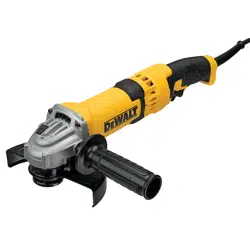Loading ...
Loading ...
Loading ...

English
6
• Use the appropriate dust extractor vacuum to
remove the vast majority of static and airborne
dust. Failure to remove static and airborne dust could
contaminate the working environment or pose an
increased health risk to the operator and those in
closeproximity.
• Use clamps or other practical ways to secure and
support the workpiece to a stable platform. Holding
the work by hand or against your body is unstable and
may lead to loss of control and injury.
• Do not use Type 11 (flaring cup) wheels on this tool.
Using inappropriate accessories can result in injury.
• Always use auxiliary handle. Tighten the handle
securely. The auxiliary handle should always be used to
maintain control of the tool at all times.
• When starting the tool with a new or replacement
wheel, or a new or replacement wire brush installed,
hold the tool in a well protected area and let it run
for one minute. If the wheel has an undetected crack or
flaw, it should burst in less than one minute. If the wire
brush has loose wires, they will be detected. Never start
the tool with a person in line with the wheel. This includes
the operator.
• To prevent the spindle end from contacting the
bottom of the hole of the hubbed wheel, use
accessories that have a threaded hole depth of
at least 21 mm. Failure to use an accessory with the
appropriate thread depth could result in damage to the
hubbed wheel and injury to the operator or persons in
the area.
• Avoid bouncing the wheel or giving it rough
treatment. If this occurs, stop the tool and inspect the
wheel for cracks or flaws.
• Always handle and store wheels in a careful manner.
• Do not operate this tool for long periods of time.
Vibration caused by the operating action of this tool may
cause permanent injury to fingers, hands, and arms. Use
gloves to provide extra cushion, take frequent rest periods,
and limit daily time of use.
• Safety goggles or safety glasses with side shields
and a full face shield compliant with ANSI Z87.1
MUST be worn by the operator and others that are
within 50' (15.2 m) of the use of this product.
• Air vents often cover moving parts and should
be avoided. Loose clothes, jewelry or long hair can be
caught in movingparts.
• An extension cord must have adequate wire size
(AWG or American Wire Gauge) for safety. The smaller
the gauge number of the wire, the greater the capacity
of the cable, that is, 16 gauge has more capacity than 18
gauge. An undersized cord will cause a drop in line voltage
resulting in loss of power and overheating. When using
more than one extension to make up the total length,
be sure each individual extension contains at least the
minimum wire size. The following table shows the correct
size to use depending on cord length and nameplate
ampere rating. If in doubt, use the next heavier gauge. The
lower the gauge number, the heavier thecord.
Minimum gauge for Cord sets
Volts
Total length of Cord in Feet
(meters)
120 V 25 (7.6) 50 (15.2) 100 (30.5) 150 (45.7)
240 V 50 (15.2) 100 (30.5) 200 (61.0) 300 (91.4)
Ampere Rating
American Wire gauge
More
Than
not
More
Than
0 6 18 16 16 14
6 10 18 16 14 12
10 12 16 16 14 12
12 16 14 12 Not Recommended
The label on your tool may include the following symbols. The
symbols and their definitions are asfollows:
V ......................... volts
Hz .......................hertz
min ..................... minutes
or DC ......direct current
...................... Class I Construction
(grounded)
…/min ..............per minute
BPM .................... beats per minute
IPM ..................... impacts per minute
RPM .................... revolutions per
minute
sfpm ................... surface feet per
minute
SPM .................... strokes per minute
A ......................... amperes
W ........................watts
or AC ...........alternating current
or AC/DC .... alternating or
direct current
...................... Class II
Construction
(double insulated)
n
o
.......................no load speed
n .........................rated speed
......................earthing terminal
.....................safety alert symbol
.....................visible radiation
..................... wear respiratory
protection
..................... wear eye
protection
..................... wear hearing
protection
..................... read all
documentation
Lanyard Connection (Fig. B)
DWE43066n, DWE43115n
safety Warnings specific for Use At height
WARNING: If the tool is dropped for any reason the
lanyard connection must be inspected and properly
serviced prior to re-use. The lanyard connection is
designed to stretch to absorb the shock of a drop.
Any permanent stretch to the connection exposing
the red marked internal coils indicates it has been
compromised and must be serviced prior to reuse.
• Always keep the tool and accessories tethered when
working "at height". (Maximum lanyard length:
6.5 ft [2m])
• Use only with lanyards appropriate for this tool type and
rated for at least 6.0 lbs (2.72 Kg).
• Crush, cut or entanglement hazard. Do not use near
moving parts, mechanisms or runningmachinery.
• Do not anchor the tool lanyard to anything on your body.
Anchor to a rigid structure that can withstand the forces
of a droppedtool.
• Make sure the lanyard is properly secure at each end prior
touse.
Loading ...
Loading ...
Loading ...
